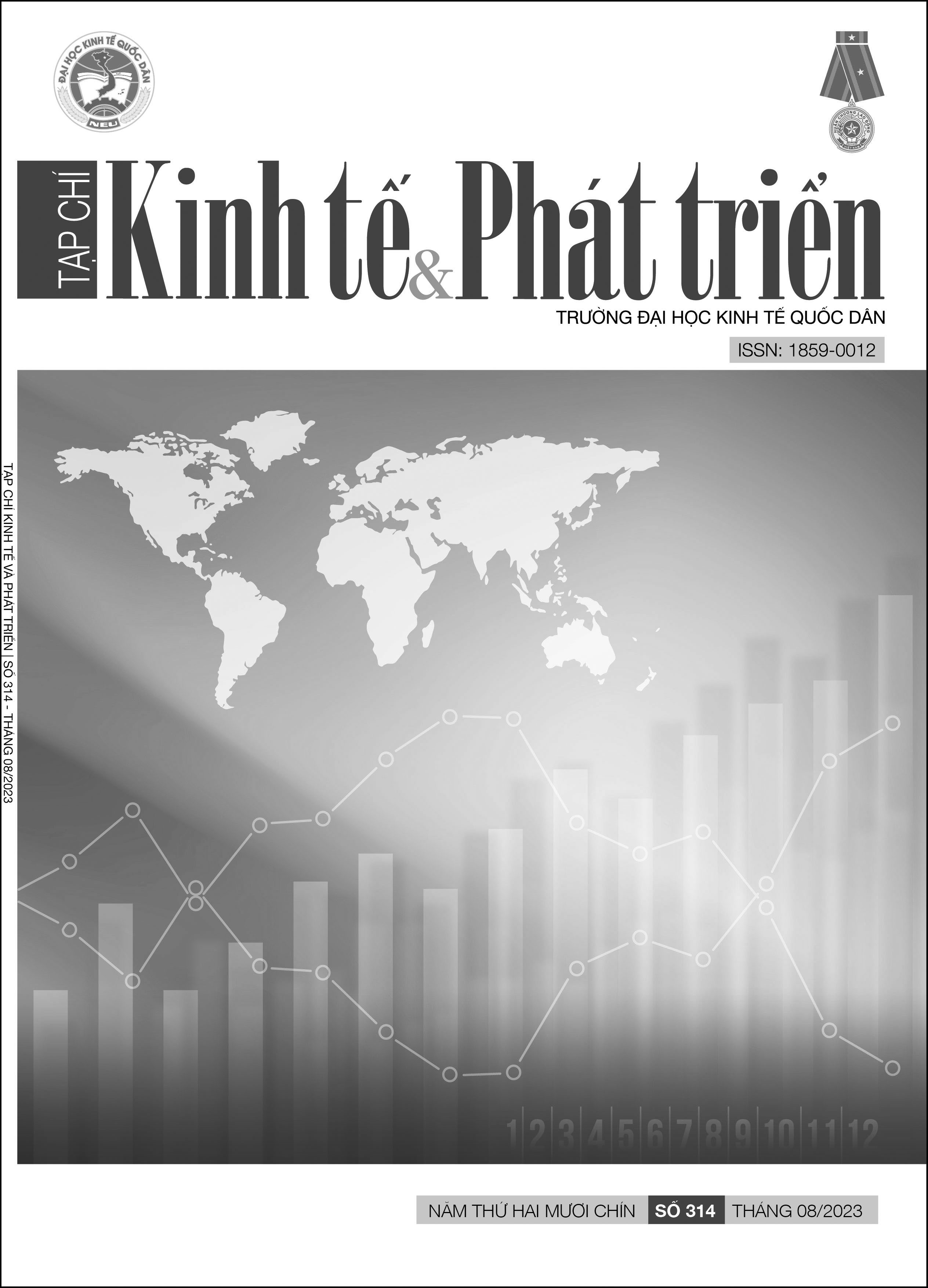Dự báo VaR và ES với khung thời gian dài ngày: Ứng dụng với thị trường Việt Nam
DOI:
https://doi.org/10.33301/JED.VI.1140Từ khóa:
Giá trị chịu rủi ro, Giá trị thua lỗ dự kiến, Dự báo rủi roTóm tắt
Nghiên cứu này đánh giá khả năng dự báo gia trị chịu rủi ro (VaR) và giá trị thiếu hụt dự kiến (ES) cho khung thời gian dài ngày đối với thị trường chứng khoán Việt Nam. Cụ thể, nghiên cứu so sánh dự báo VaR và ES với khung thời gian 10-ngày cho chỉ số VN-Index và HNX-Index tại hai mốc phân vị phổ biến là 1% và 5% từ phương pháp phi tham số, bán tham số và tham số. Với các kiểm định đa dạng so sánh khả năng dự báo tuyệt đối và tương đối của các phương pháp, kết quả thực nghiệm cho thấy mô hình Gjr-Sge với giả định phân phối xác suất Skewed Generalized Error (SGE) cho chỉ số giá chứng khoán Việt Nam mang lại kết quả dự báo ổn định và tốt nhất ở khung thời gian 10-ngày. Nghiên cứu này nhấn mạnh việc ghi nhận tính không chuẩn trong phân phối xác suất tỷ lệ sinh lời của thị trường chứng khoán Việt Nam và giúp đề xuất mô hình đo lường phù hợp cho các tổ chức tài chính và nhà đầu tư khi tham gia vào thị trường chứng khoán Việt Nam.
Tài liệu tham khảo
Basel Committee on Banking Supervision (2019), Minimum Capital Requirements for Market Risk, Technical Report, https://www.bis.org/bcbs/publ/d457.htm.
Berkowitz, J., Christoffersen, P., & Pelletier, D. (2011), ‘Evaluating value-at-risk models with desk-level data’, Management Science, 57(12), 2213-2227.
Bollerslev, T. (1987), ‘A conditionally heteroskedastic time series model for speculative prices and rates of return’, The review of economics and statistics, 69(3), 542-547.
Brownlees, C., Engle, R., & Kelly, B. (2011), ‘A practical guide to volatility forecasting through calm and storm’, The Journal of Risk, 14(2), 3-22.
Degiannakis, S., & Potamia, A. (2017), ‘Multiple-days-ahead value-at-risk and expected shortfall forecasting for stock indices, commodities and exchange rates: Inter-day versus intra-day data’, International Review of Financial Analysis, 49, 176-190.
Engle, R. F. (2011), ‘Long-term skewness and systemic risk’, Journal of Financial Econometrics, 9(3), 437-468.
Engle, R. F., & Manganelli, S. (2004), ‘CAViaR: Conditional autoregressive value at risk by regression quantiles’, Journal of business & economic statistics, 22(4), 367-381.
Fama, E. F., & French, K. R. (2018), ‘Long-horizon returns’, The Review of Asset Pricing Studies, 8(2), 232-252.
Fissler, T., Ziegel, J. F., & Gneiting, T. (2015), ‘Expected Shortfall is jointly elicitable with Value at Risk-Implications for backtesting’, arXiv preprint arXiv:1507.00244.
Ghysels, E., Santa-Clara, P., & Valkanov, R. (2006), ‘Predicting volatility: getting the most out of return data sampled at different frequencies’, Journal of Econometrics, 131(1-2), 59-95.
Giacomini, R., & Komunjer, I. (2005), ‘Evaluation and combination of conditional quantile forecasts’, Journal of Business & Economic Statistics, 23(4), 416-431.
Glosten, L. R., Jagannathan, R., & Runkle, D. E. (1993), ‘On the relation between the expected value and the volatility of the nominal excess return on stocks’, The journal of finance, 48(5), 1779-1801.
Gneiting, T. (2011), ‘Making and evaluating point forecasts’, Journal of the American Statistical Association, 106(494), 746-762.
Jiang, K., Zeng, L., Song, J., & Liu, Y. (2022), ‘Forecasting Value-at-Risk of cryptocurrencies using the time-varying mixture-accelerating generalized autoregressive score model’, Research in International Business and Finance, 61, 101634.
Koenker, R., & Bassett Jr, G. (1978), ‘Regression quantiles’, Econometrica: journal of the Econometric Society, 48 (1), 33-50.
Kupiec, P. H. (1995), ‘Techniques for Verifying the Accuracy of Risk Measurement Models’, The Journal of Derivatives, 3(2), 73-84.
Lê Hải Trung & Nguyễn Thị Mai Trang (2020), ‘Các phương pháp đo lường giá trị chịu rủi ro: Ứng dụng cho Việt Nam’, Tạp chí Khoa học và Đào tạo Ngân hàng, 221, 50-58.
Lê Hải Trung (2020), ‘Forecasting value at risk and expected shortfall with mixed data sampling’, International Journal of Forecasting, 36(4), 1362-1379.
McNeil, A. J. & Frey, R. (2000), ‘Estimation of tail-related risk measures for heteroscedastic financial time series: an extreme value approach’, Journal of Empirical Finance, 7(3-4), 271–300.
Neuberger, A. (2012), ‘Realized skewness. Review of Financial Studies, 25(11), 3424-3455.
Nieto, Maria Rosa & Esther Ruiz. (2016), ‘Frontiers in VaR Forecasting và Backtesting’, International Journal of Forecasting, 32 (2), 475–501.
Novales, A. and Garcia-Jorcano, L. (2018), ‘Backtesting extreme value theory models of
expected shortfall’, Quantitative Finance, 7688, 1-27
Patton, A. J., Ziegel, J. F., & Chen, R. (2019), ‘Dynamic semiparametric models for expected shortfall (and value-at-risk)’, Journal of econometrics, 211(2), 388-413.
Slim, S., Koubaa, Y., & BenSaida, A. (2017), ‘Value-at-Risk under Lévy GARCH models: Evidence from global stock markets’, Journal of International Financial Markets, Institutions and Money, 46, 30-53.
Taylor, J. W. (2019), ‘Forecasting value at risk and expected shortfall using a semiparametric approach based on the asymmetric Laplace distribution’, Journal of Business & Economic Statistics, 37(1), 121-133.
Theodossiou, P. (2015), ‘Skewed generalized error distribution of financial assets and option pricing’, Multinational Finance Journal, 19(4), 223-266.





